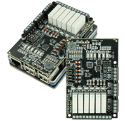Raspberry Pi CM3+ based gateway combines BACnet and LoRaWAN
Apr 14, 2021 — by Eric Brown 923 views Innovelec’s “Dingo LoRaWAN BACnet” gateway runs a Linux-based Dingo stack on an RPi CM3+ and can control up to 2,000 LoRaWAN end nodes as virtual BACnet building control devices.
Innovelec’s “Dingo LoRaWAN BACnet” gateway runs a Linux-based Dingo stack on an RPi CM3+ and can control up to 2,000 LoRaWAN end nodes as virtual BACnet building control devices.
UK-based Innovelec has announced a Dingo LoRaWAN BACnet Advanced Gateway/Server that combines a LoRaWAN gateway with local I/O features compatible with the BACnet building automation standard. The 2-station gateway runs Innovelec’s BACnet-compatible Dingo Stack along with its Dingo Stack LoRaWAN Server software on a Raspberry Pi Compute Module 3+. The gateway can integrate LoRaWAN equipped edge nodes into a BACnet network as virtual BACnet devices and supports applications ranging from building and campus management systems to smart agriculture to environmental monitoring.


Dingo LoRaWAN BACnet Advanced Gateway/Server
(click images to enlarge)
The Dingo LoRaWAN BACnet gateway starts at 742.75 UK Pounds ($1,020.90) and ships with 1-year license for the Dingo Stack Base Engine, LoRaWAN Gateway, LoRaWAN Server (including ADR), and Dingo Manager control and configuration dashboard. You also get an hour of remote support and a year of software updates.
The default package supports 100 BACnet objects, but you can select options up to 1,000 objects on the shopping page, and up to 10,000 according to the marketing materials. Each node/sensor typically requires 6-10 objects. The LoRaWAN gateway supports up to 2,000 LoRaWAN end nodes at distances of 10km or more.
— ADVERTISEMENT —
The Dingo LoRaWAN BACnet gateway can connect with BACnet/IP and BACnet/WS compatible devices with secure end-to-end encryption and “an advanced data rate (ADR) control algorithm which constantly monitors each end node link and adapts data-rate and power level to both preserve battery life and mitigate interference,” says Innovelec. Device parameters like battery-status and signal-strength can optionally be mapped to BACnet objects for local or remote logging and surveillance.
 BASpi |
We have previously seen BACnet support on Contemporary Controls’ $69-and-up BASpi add-on board for the Raspberry Pi. The BASpi lacks LoRaWAN support, however, and offers fewer features.
The gateway’s Raspberry Pi CM3+ module has a quad-core, Cortex-A53 Broadcom BCM2837B0 with 1GB of LPDDR2 RAM and 8GB to 32GB eMMC. The gateway provides 10/100Mbps and 10BASE-T (10Mbps over twisted pair) Ethernet ports.
The Dingo LoRaWAN BACnet gateway supports LoRaWAN 1.0.2 and V1.0.3 in a variety of frequency bands for US, EU, and more. The LoRaWAN modem offers up to 25dBm transmission power and supports simultaneous inputs from 8x LoRa channels. An external antenna is provided.
Options include a 4G modem and Wireless MBUS, each for 75 Pounds ($103), as well as a WiFi option, for which we did not see pricing. Options for wired connections include opto-isolated MBUS and RS485/Modbus.
The gateway, which we saw on CNXSoft, is further equipped with HDMI and USB 2.0 ports, 8x opto-isolated inputs, and 2x relays. Other features include an RTC with battery, a 128×64 pixel OLED display, and 17x LEDs.
There is an external 12V/1A DC supply, with other options including a 31-Pound ($43) internal supply. The DIN-rail or screw-mountable, 105 x 90 x 58mm system has a -20 to 55°C operating range and IP20 protection.
Further information
The Dingo LoRaWAN BACnet Advanced Gateway/Server starts at 742.75 UK Pounds ($1,020.90). More information may be found at Innovelec’s shopping page.

Please comment here...